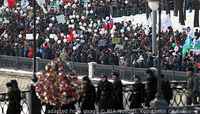Vedomosti Misrepresented Survey Results in Recent Article [Re: Protests]

From: “William Dunkerley” <wd@publishinghelp.com>
Subject: Vedomosti Misrepresented Survey Results in Recent Article
Date: Mon, 5 Nov 2012
Vedomosti Misrepresented Survey Results in Recent Article
By William Dunkerley
William Dunkerley is a media business analyst and consultant specializing in Russia and the former Soviet Union.
An October 30, 2012 Vedomosti article titled “No Pathologies in Anatomy: Russians disbelieve that protesters meant to topple the regime” (JRL #191) offers survey data to make its point. But in doing so, the newspaper jiggered the statistics.
Vedomosti claimed, “The campaign against the street opposition failed. The Russians obstinately refuse to believe that protesters and organizers of protests meant to topple the regime.”
The “campaign” Vedomosti refers to is apparently an NTV documentary “Anatomy of a protest – 2.” The show took aim at demonstration leaders, portraying them in a negative light.
The newspaper staked its conclusion that the program failed on the Levada Center finding that only 24 percent of Russians believe the protest organizers are seeking revolution, which was a premise of the documentary. But that was a bogus conclusion. Vedomosti presented no statistics to show what that percentage was before the documentary aired. Thus there was no showing of change in beliefs, one way or another. There might have been a lesser percentage of people before the show. Who knows? And the survey certainly didn’t measure the “obstinateness” that Vedomosti claimed it did.
Vedomosti also trumpeted the Levada finding that 27 percent of Russians labeled the administration’s actions regarding demonstrations as political repression. What Vedomosti failed to mention is that this figure represents the smallest group of respondents to that question. Thirty-nine percent saw the government acting to restore law and order. That was the predominant reaction. Another 35 percent found it hard to decide what was in the administration’s mind. There was no mention of these more significant numbers in the Vedomosti story. The newspaper presented a misleading picture.
Vedomosti’s misuse of the Levada Center survey data raises the question of what the newspaper was trying to do. Was this really a journalistic story aimed at informing readers accurately? Or was the newspaper participating in an opposition media attack on the administration?
While it seems clear that Vedomosti’s rationale for calling the NTV documentary a failure is illegitimate, I nonetheless agree the show was a failure — but for a different reason. It failed to draw a significant audience. According to the Levada data, only 3 percent of Russians watched it. That’s not much of a success. What’s more, the documentary gave the opposition a chance to launch its media attack. I think it’s time the Kremlin wised up and took a more sophisticated approach in handling the multitude of media attacks it receives.
Vedomosti Misrepresented Survey Results in Recent Article
From: “William Dunkerley” <wd@publishinghelp.com>
Subject: Vedomosti Misrepresented Survey Results in Recent Article
Date: Mon, 5 Nov 2012
Vedomosti Misrepresented Survey Results in Recent Article
By William Dunkerley
William Dunkerley is a media business analyst and consultant
specializing in Russia and the former Soviet Union.
An October 30, 2012 Vedomosti article titled “No Pathologies
in Anatomy: Russians disbelieve that protesters meant to
topple the regime” (JRL #191) offers survey data to make its
point. But in doing so, the newspaper jiggered the
statistics.
Vedomosti claimed, “The campaign against the street
opposition failed. The Russians
obstinately refuse to believe that protesters and organizers
of protests meant to topple the regime.”
The “campaign” Vedomosti refers to is apparently an NTV
documentary “Anatomy of a protest – 2.” The show took aim at
demonstration leaders, portraying them in a negative light.
The newspaper staked its conclusion that the program failed
on the Levada Center finding that only 24 percent of
Russians believe the protest organizers are seeking revolution, which was a premise of the documentary. But that
was a bogus conclusion. Vedomosti presented no statistics to
show what that percentage was before the documentary aired.
Thus there was no showing of change in beliefs, one way or
another. There might have been a lesser percentage of people
before the show. Who knows? And the survey certainly didn’t
measure the “obstinateness” that Vedomosti claimed it did.
Vedomosti also trumpeted the Levada finding that 27 percent
of Russians labeled the administration’s actions regarding
demonstrations as political repression. What Vedomosti
failed to mention is that this figure represents the
smallest group of respondents to that question. Thirty-nine
percent saw the government acting to restore law and order.
That was the predominant reaction. Another 35 percent found
it hard to decide what was in the administration’s mind.
There was no mention of these more significant numbers in
the Vedomosti story. The newspaper presented a misleading
picture.
Vedomosti’s misuse of the Levada Center survey data raises
the question of what the newspaper was trying to do. Was
this really a journalistic story aimed at informing readers
accurately? Or was the newspaper participating in an
opposition media attack on the administration?
While it seems clear that Vedomosti’s rationale for calling
the NTV documentary a failure is illegitimate, I nonetheless
agree the show was a failure — but for a different reason.
It failed to draw a significant audience. According to the
Levada data, only 3 percent of Russians watched it. That’s
not much of a success. What’s more, the documentary gave the
opposition a chance to launch its media attack. I think it’s
time the Kremlin wised up and took a more sophisticated
approach in handling the multitude of media attacks it
receives.
